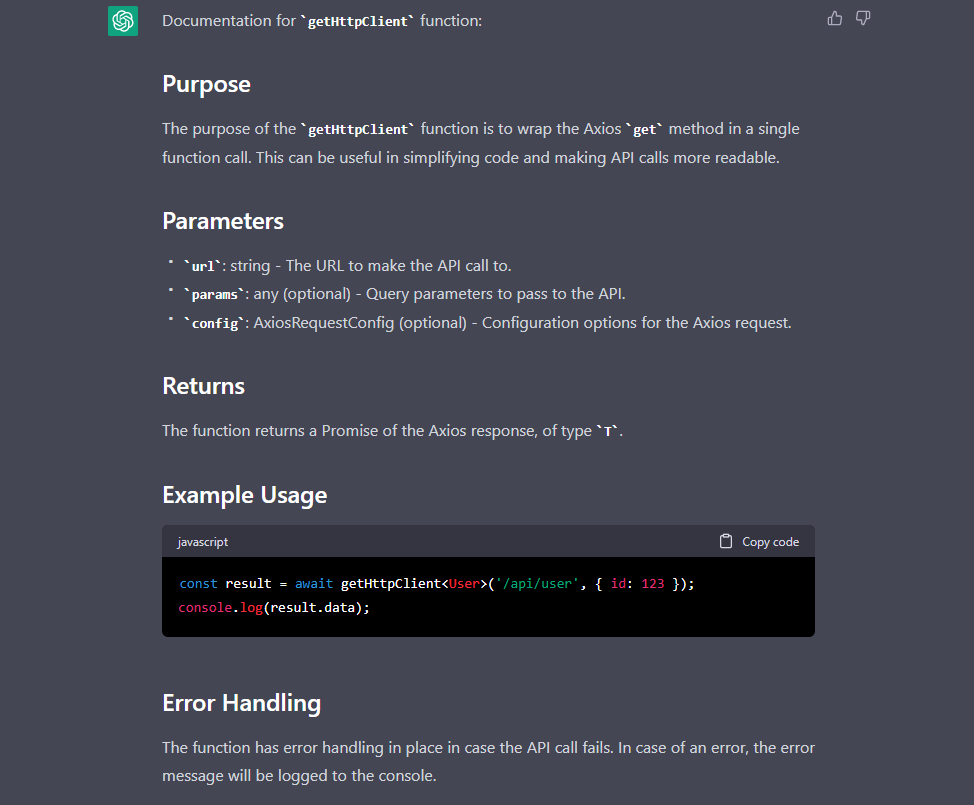Table of Contents
ChatGPT is a trendy topic in all industries, but today let’s discuss the top use cases of this AI tool for developers. It is a long-form question-answering AI from OpenAI that responds to complicated questions. It’s an exciting new technology being taught to understand and respond to questions posed by people. OpenAI launched ChatGPT in November 2022, a chatbot with a significant language model. This language model can help you with coding, email creation, and essay writing and answer your inquiries.
Key ChatGPT facts and statistics
- Launch Date: November 30, 2022
- Number of Users: 100 million active users in January 2023 and 173 million users in April 2023
- 60 million visits per day
- 1.8 billion monthly visits in April 2023
- Microsoft has already invested $1 Billion and confirmed an additional investment of $10 billion in Open AI. Bing got a 15% Daily Traffic Bump from its Integration
- It has an accuracy of 85+ %, which is a good percentage, and it can even write flawless code snippets, making it a valuable tool for software engineering
- It has been dubbed “the best AI chatbot ever released” by the New York Times
- It can understand more than 12 programming languages
- 49% of businesses currently use ChatGPT
Currently, generative AI can assist in bridging gaps and expediting the implementation of solutions in the software development life cycle. However, developers will continue to play a crucial role in driving appropriate experiences. While AI can provide coding examples at present, in the future, AI models might aid engineers in answering questions about architectures and design patterns. Nevertheless, it remains challenging to envision a scenario where a single AI can replace software development teams’ extensive knowledge, innovation, and decision-making capabilities. These teams are responsible for crafting exceptional customer experiences and ensuring productive workflows, and their expertise and input are indispensable in achieving these goals.
ChatGPT in software development: use cases
In terms of software development, ChatGPT is a potent tool for developers:
It serves as a tool that reduces the necessity for extensive manual coding, fulfilling a long-standing requirement within the development community. Developers often encounter frustration when dealing with repetitive coding tasks. However, this chat offers a solution by enabling developers to simply instruct the AI tool to generate automated code on their behalf. This streamlines the development process, allowing developers to delegate repetitive coding tasks to ChatGPT and focus their efforts on other aspects of their projects.
It also possesses exceptional natural language processing capabilities, enabling it to comprehend and interpret the needs of developers. ChatGPT can provide relevant code snippets, potentially saving programmers significant time regarding repetitive tasks or boilerplate code.
Programmers can utilize the chat to effortlessly generate plain language explanations for intricate code sections, facilitating comprehension and maintenance for others. By automatically generating code comments and documentation, ChatGPT simplifies the code and reduces the effort required from developers. Furthermore, due to its ability to understand the code’s underlying logic and structure, the documentation and comments produced by the chat are often more accurate and informative than those written by developers. The chat can also assist programmers in refactoring and optimizing their code, offering suggestions for improvements such as reducing code length or enhancing efficiency, thus enhancing performance, improving code readability and manageability, and reducing the occurrence of bugs.
In addition to its code-related capabilities, ChatGPT is a valuable knowledge resource for developers, comparable to a search engine or a question-and-answer website like Stack Overflow. It comprehends complex programming concepts and provides developers with relevant information. By utilizing this chat as a search engine, developers can quickly obtain answers to specific questions by interacting with the model. ChatGPT offers relevant code samples and snippets, saving developers time and effort searching for code examples or snippets online. This proves especially beneficial when developers need to implement specific features or solve problems quickly.
ChatGPT can accurately generate comprehensive documentation for code requirements by leveraging its natural language processing skills. This significantly saves time for developers, who often spend considerable effort creating extensive documentation. By providing a code snippet, developers can instruct it to generate documentation that explains the function’s purpose, inputs, outputs, and other relevant details. The chat can generate documentation for entire classes or modules, offering a comprehensive code overview. The generated documentation can be in various formats, such as Markdown, HTML, or JSDoc, making integration with code editors seamless, ensuring the codebase is well-documented and making it easier for other developers to understand and work with.

Another valuable application of ChatGPT is in writing test cases. The chat can analyze the logic and structure of the provided code, allowing it to generate test cases that cover various code paths and edge cases. Developers can provide a code snippet and specify requirements, such as handling large data sets, and it can generate appropriate test inputs. ChatGPT can also generate test case documentation, providing concise descriptions of the test cases, including information, predicted outcomes, and pass/fail conditions. This simplifies the process of updating test cases, even for developers without extensive testing knowledge.
The OpenAI chat proves to be a valuable tool for developers seeking to improve code performance. It can suggest alternative code implementations that are more efficient and effective, and easier to read and maintain. It can recommend ways to enhance performance by evaluating code, such as reducing operations or optimizing memory usage. These suggestions help developers write more efficient code, improving scalability and speed of execution. Furthermore, by recommending code restructuring, ChatGPT can help identify and eliminate bugs, improving code readability, maintainability, and overall quality.
Communication between technical and non-technical stakeholders can indeed be a significant challenge in software development. Stakeholders such as project managers, business analysts, and customers may not possess the same technical proficiency as developers. In such cases, this OpenAI chat can be an invaluable tool for bridging this gap.
ChatGPT’s natural language processing capabilities enable it to interpret technical jargon and provide plain-language explanations. This empowers developers to communicate complex technical concepts to non-technical stakeholders effectively. Using ChatGPT as a mediator, developers can ensure that everyone involved in the project, regardless of their technical background, comprehends and aligns with the project goals, timelines, and deliverables.
The ability to communicate in a language that non-technical stakeholders understand fosters collaboration minimizes misunderstandings and promotes a shared understanding of the project’s requirements and progress. It allows stakeholders to provide valuable input and make informed decisions, leading to more successful outcomes and improved project outcomes overall.
As a programmer, having placeholder data for various purposes is often necessary. Whether it’s for testing APIs with database data or populating web pages with sample text, ChatGPT can be a valuable resource for generating different types of dummy data tailored to your needs.
ChatGPT can generate filler content in various formats, including SQL, JSON, CSV, and many others. Additionally, it can create native data structures like arrays and lists in your preferred programming language. While online tools are available for generating dummy data, they may not offer the same level of customization as ChatGPT. With ChatGPT, you can specify specific requirements and generate highly customized dummy data.
For example, you can ask ChatGPT to generate a CSV file with 2,000 records containing English first names, Chinese second names in their anglicized form, and US phone numbers. You can be as specific as you need with the type of dummy data you require. This level of customization is not readily achievable with free online dummy data-generating tools.
ChatGPT can indeed assist in the process of porting code from one programming language to another. The AI chatbot has been trained in a wide range of programming languages and possesses the capability to convert code between them with an exceptional level of accuracy. This functionality extends not only to modern programming languages but also to migrating deprecated or legacy code to more stable code within the same language.
To utilize this feature, you must provide ChatGPT with appropriate prompts and instructions, specifying the source code language and the desired target language. With this information, ChatGPT can generate the converted code in the language of your choice, making it easier and faster to transition between different programming languages or upgrade legacy codebases.
By leveraging ChatGPT’s ability to port code, developers can save time and effort that would otherwise be spent manually rewriting or refactoring code. However, it is essential to note that while ChatGPT can provide accurate translations, it is still recommended to thoroughly review and test the ported code to ensure its functionality and maintainability in the target language.
ChatGPT can offer valuable recommendations for setting up and configuring continuous integration and deployment (CI/CD) pipelines. Developers can describe their project’s specific requirements, and ChatGPT can provide suggestions on popular tools, workflows, or strategies for achieving an efficient CI/CD implementation.

By leveraging its training on a vast amount of programming knowledge, ChatGPT can understand the context of your project and offer insights on best practices for CI/CD pipelines. Based on your project’s needs, it can recommend popular CI/CD tools such as Jenkins, GitLab CI/CD, or CircleCI. Additionally, ChatGPT can suggest effective workflows and strategies for automating build, testing, and deployment processes to enhance the overall development lifecycle.
These recommendations can include suggestions on code integration, automated testing frameworks, version control practices, deployment strategies, and more. By following the directions provided by ChatGPT, developers can streamline their development workflows, improve code quality, and achieve faster and more reliable software delivery.
It is essential to keep in mind that while ChatGPT can provide valuable recommendations, it is always advisable to validate and adapt these suggestions to fit your specific project requirements and organizational context.
ChatGPT can be a great tool for gathering requirements in the context of application development. Its interactive conversational capabilities enable it to engage with stakeholders and facilitate the process of understanding their needs, preferences, and desired functionalities.
Developers can leverage ChatGPT by initiating interactive conversations with stakeholders and utilizing it as a virtual assistant to ask questions, provide prompts, and capture essential information. By guiding the conversation, developers can elicit detailed requirements from stakeholders and ensure a comprehensive understanding of their expectations.
ChatGPT can assist in clarifying requirements, exploring different scenarios, and validating assumptions. It can help stakeholders articulate their needs by asking probing questions and providing suggestions. Through this iterative process, developers can refine and document the requirements effectively.
Using ChatGPT for requirements gathering can enhance collaboration between developers and stakeholders. It allows for a more interactive and dynamic approach, enabling stakeholders to express their needs conversationally. This can lead to improved accuracy and completeness of the gathered requirements.
However, it is essential to note that while ChatGPT can facilitate the requirements-gathering process, human validation, and analysis are still necessary. Developers should carefully review and validate the gathered requirements, ensuring they align with the stakeholders’ intentions and the overall project goals.
Indeed, ChatGPT can be a valuable tool for knowledge sharing and onboarding purposes within software development teams. It can effectively assist in sharing knowledge, conducting training sessions, and helping onboard new team members.
With its natural language processing capabilities, ChatGPT can answer questions and explain various software development concepts, best practices, and project-specific information. Enabling team members to quickly access the information they need, promoting a smoother onboarding process, and facilitating continuous learning within the team.
ChatGPT can offer guidance on topics such as programming languages, frameworks, design patterns, development methodologies, version control, and more. It can help explain complex technical concepts in a simplified manner, making it easier for newcomers to grasp important information and aiding in their transition into the team.
Additionally, ChatGPT can provide insights into specific project-related information, such as architecture design decisions, project documentation, coding conventions, or project-specific workflows. Helping team members align their understanding and work effectively towards shared goals.
By leveraging ChatGPT for knowledge sharing and onboarding, software development teams can foster a collaborative and learning-oriented environment, enabling smoother knowledge transfer and reducing the time required for new members to get up to speed.
“Artificial intelligence is not a substitute for human intelligence; it’s a tool for extending it.” -Brynjolfsson and McAfee
It is important to note that, despite its many benefits, ChatGPT is not infallible. It can struggle with basic math, sometimes misunderstand simple logic, and even provide entirely false information in its responses. OpenAI acknowledges this issue and states that ChatGPT “sometimes writes plausible-sounding but incorrect or nonsensical answers.” Additionally, as ChatGPT is trained on a wide range of written data, it may exhibit biases
ChatGPT is indeed a valuable tool for developers seeking to enhance their productivity and efficiency. Its capability to generate code snippets, provide answers to questions, and create documents quickly can be highly beneficial. Nonetheless, it’s crucial to remember that the responses generated by ChatGPT may not always be entirely accurate. Therefore, conducting thorough research and verification is essential before relying on ChatGPT for more complex or critical tasks. While ChatGPT can be a time-saving resource, exercising caution and performing due diligence is necessary to ensure the reliability and correctness of the information provided by the model.
If you are interested in knowing more about the usage of ChatGPT in software development, I recommend you to check these articles as well written by our Android developer – Isaac:
- GPT-4: The New OpenAI Model
- Midjourney: The AI That Won Over Humans
- DALL-E and the Future of Art
- Using GPT-3 in our applications
- GPT-3 Playground, the AI that can write for you
And if you need help with custom software development or tech governance, let us know! We have leading software architecture and DevOps experts on our team!
Author
-
Ekaterina Novoseltseva is an experienced CMO and Board Director. Professor in prestigious Business Schools in Barcelona. Teaching about digital business design. Right now Ekaterina is a CMO at Apiumhub - software development hub based in Barcelona and organiser of Global Software Architecture Summit. Ekaterina is proud of having done software projects for companies like Tous, Inditex, Mango, Etnia, Adidas and many others. Ekaterina was taking active part in the Apiumhub office opening in Paseo de Gracia and in helping companies like Bitpanda open their tech hubs in Barcelona.
View all posts










2 Comments
Bhaskar Sharma
This blog post on using ChatGPT for developers is a valuable resource for anyone looking to leverage the power of ChatGPT in their projects. The insights and practical guidance shared by Apiumhub provide a comprehensive understanding of the capabilities and integration possibilities of this advanced language model. Thank you for sharing this informative guide!
Mike
I have experimented with using ChatGPT to assist in developing some software applications, and while it can provide valuable information, relying solely on ChatGPT for software application development is not a prudent decision. While there is potential for ChatGPT to become more capable in the future, at present, I believe it is not yet fully equipped for complete reliance on software development.